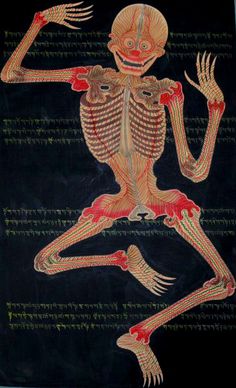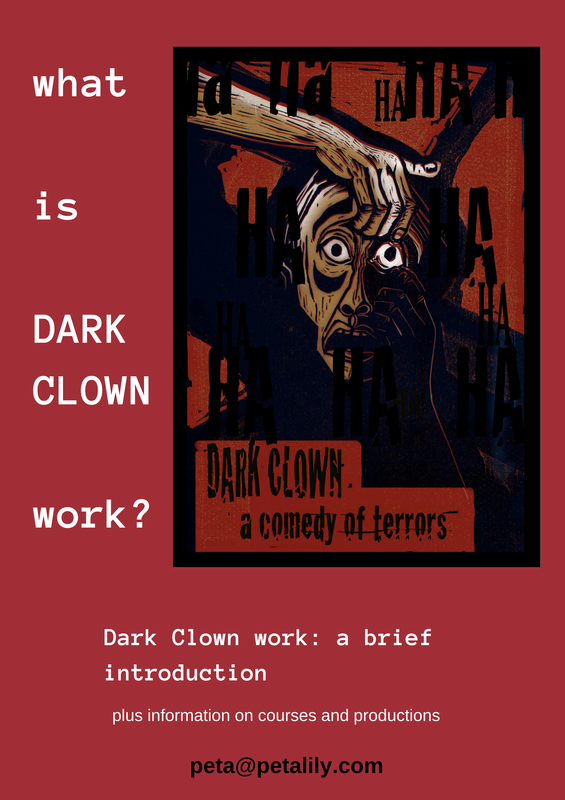 one of the 'Lords of the Cemetery'
one of the 'Lords of the Cemetery' In my paper ‘The Comedy of Terrors, Dark Clown and Enforced Performance’, I suggest that ‘the Dark Clown is useful, because it provides an opportunity for audiences and performers to engage with some of the dark absurdities and obscenities of this world, when drama and sentiment can fall short of touching us. The Holocaust, Pol Pot’s regime in Cambodia, and more recent events are horrors of such magnitude and incomprehensibility that we are in danger of numbing out even as we try to contemplate them.’
When I introduce Dark Clown, I always describe to groups a particular scene of Pip Simmonds’ 1980’s production An die Musik, where a performer plays a man in a prison camp dancing for his life. He is humiliated, desperate to stay alive and horrified to see what he has been driven to. Watching this scene, I had the privilege of being able to both squirm at the ghastly subtraction of his dignity, and also to vividly witness it. Simultaneously I was able to release the pent up energy of my own guilt through this vigorous form of laughter - which at a physiological level shares something with the act of sobbing.
Dark Clown is a performance style, not a spiritual practice. It is a challenging yet rewarding work to teach. Because of its dark content and unusual nature, sometimes people become upset and sometimes questions are raised. I have created an introduction to the work that explains that upset may possibly happen and how to proceed if it does. I have also found a way to give the right information and framework for the work, making it clear that the work is best experienced rather than described – we progress towards it step by step. Until all the work has been done, discussion is too hypothetical to be useful. Once the work has been done, most would-be questions been resolved.
It is natural that some people sometimes become upset. 1 the content is dark, 2 the work requires a certain extremity of physicality 3 the work requires an imaginative investment in circumstances chosen to create sufficiently high stakes for the performer to release into the rhythms and states of the Dark Clown 4 sometimes people have events in their lives that get triggered by a detail of the work. Usually a glass of water and a breath outside the room is enough for people to be able to return to the work.
Sometimes fear arises from people’s horror that they might be making light of the terrible suffering of others. And that fear can be manifested in a question or a resistant statement. I always clarify, with emphasis, when teaching Dark Clown, that my intention is not to make fun of suffering or to make fun of those who have suffered. It is my intention to give audiences the experience of finding themselves laughing and at the same time - or a beat later - to feel terrible that they have laughed.
But occasionally, a course participant’s emotions surge, and despite the information in introduction – they verbalise a reaction along the lines of: 'but this work is wrong!’ or 'you / I cannot laugh at this’.
In these moments the conversation has to become wider still. And last year it occurred to me to mention to a troubled course participant the possibility of a resonance with Tantric contemplation of horror. I found this blog entry on 'Disgust, horror, and Western Buddhism’ – edited here by me (with apologies and credit and thanks to the author - please see the link to the full blog below). There's a preamble then it mentions 'tantric transformation':
‘There are two fundamental approaches in Buddhism. One is renunciation…you lessen the defiled emotions …by avoiding the things that provoke them. Then you use meditation to cut off the remainder.
There is a clear Buddhist logic to this; you can understand how renunciation ends suffering by extinguishing negative emotions.
The other approach is tantric transformation. Externally, you avoid nothing. Internally, you don’t try to get rid of negative emotions; you might even deliberately intensify them. Instead, you transform your relationship with them, so that they cease to be problems.….
Again, there is a clear Buddhist logic. If you enjoy everything, there is no suffering.
…Horror (is) as important in Tantra as in renunciate Buddhism.
The key is the realization of emptiness—the fact that things have no inherent nature. Nothing is disgusting on its own account. Disgust is just your emotional response to it. With practice, you can break your habitual perception-emotion linkage.
The most commonly-known tantric corpse practice is chöd. Ideally chöd should be practiced in a charnel ground. There you visualize your own violent death, as horrifying as possible. Then you serve your dead body as a feast for all beings, who find it utterly delicious. Chöd transforms horror into fearlessness, and transforms revulsion for death and corpses into generosity.
Chöd is just the tip of the iceberg. The tantric scriptures are full of horrifying stories and images. Tantric Buddhist art often depicts corpses or parts of corpses. Human bones are used in most tantric rituals.
....Death was taboo in the West during the formative years for leading Western Buddhist teachers. You were supposed to pretend it didn’t exist. The traditional rituals that had made dying a community event were abandoned. Death became a private, hidden, shameful matter....
Resistance to corpse practice is a Western cultural thing. Corpse practice is directly aligned with the essential principles of Buddhism. It is a powerful tool for either renunciation or tantric transformation.’
see the full blog post here:
http://meaningness.wordpress.com/2011/07/22/disgust-horror-western-buddhism/
There is an other spiritual practice that is worth mentioning here, for people who become distressed, or fear becoming distressed doing Dark Clown work.
I came across the practice of Tonglen in a book I read by Pema Chödrön, ‘When things fall apart’. She mentioned that when we suffer, we often make it more persistent and painful by resistance and / or efforting to escape. I was shocked when she advised to breathe in the mental or physical pain – ‘won’t that be harmful to my body?’ I worried. Then I tried it. Chödrön advised to breathe it in on behalf of others who are suffering something similar and to breathe out relief for them.
In this video she advises you can go straight to the suffering of others – breathe it in and then breathe out the appropriate relief for them.
People report the Dark Clown work is compelling and liberating to play – and often report that it is cathartic to witness.
In the terrible regimes mentioned in the first paragraph, psychological torture goes hand in hand with physical torture and deprivation. People have been called to make terrible choices, or reduced to the point where under pressure and shock they act out of self interest – we can only imagine their suffering. But rather than numbing out because the horror is so great we can at least see these events, these terrible moments of humanity, the beats of shame and guilt and horror that happened to people whose stories may have been lost or never seen. We can, albeit long after the fact, dignify this suffering by being a witness to its verisimilitude. And just maybe that counts for something. As Rust Cohle said in Series One of True Detective - 'and I will not look away’.
...I know I've mentioned this quote before - it's too good not to repeat.
 RSS Feed
RSS Feed
